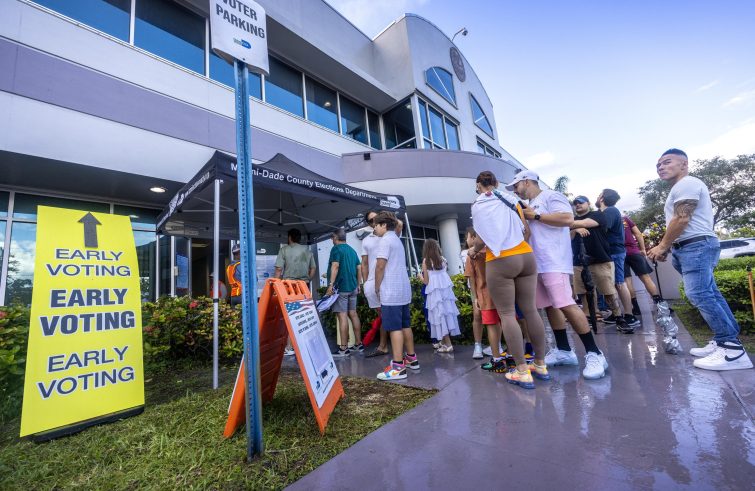
The two candidates for the White House are neck and neck in the latest polls released by NBC News on Sunday. Republican nominee Donald Trump and Democratic nominee Kamala Harris each received 49% of respondents’ preferences, with only 2% of voters undecided. In terms of specific questions, Harris beat Trump by 20 points when voters were polled on abortion and respect for institutions, while the former U.S. president led the vice president by 10 percentage points on the economy and cost of living.
While both candidates made their closing campaign speeches last week, they are still on the campaign trail in swing states in the hope of tipping the balance in their favour.
More than 75 million Americans have already made their choice through early and absentee voting ahead of election day on Tuesday 5 November. They cast their ballots out of fear for the integrity of the election process, which has been undermined by conspiracy theories and fake news spread by Russian- and China-linked hackers. They voted out of fear for the outcome of the election: Donald Trump has already made it clear that he will not accept a result that does not give him the victory, and the Republican Party has already deployed thousands of lawyers and party list representatives who are preparing to challenge every vote, especially in states where the US election could be decided by a few hundred thousand voters. US citizens have voted and will be voting, because they fear that their democracy is now the target of internal enemies, fascist trends, economic isolationism and divisions that will remain even after November 5.
Many parish bulletins this weekend included the prayer recommended by the US bishops for the elections that invites parishioners to respond as faithful citizens, in fidelity to the Gospel, to better understand the issues and concerns “facing our city/state/country”. The prayer also calls for discernment in “choosing leaders who hear your Word”. Thousands of parishes functioned as polling stations in recent weeks, enabling members of the community to cast early, in-person ballots.
Monsignor John Graham set up a polling station at St Frances de Chantal Parish in the Bronx, NYC, about a week ago. In his Sunday homily, he encouraged the faithful not to abstain from voting because “the opportunity to vote is a precious privilege and an opportunity for the faithful to add a spiritual and religious dimension to their vote”.
For this reason, rather than seeing the official opening of polling stations on Tuesday, we will be awaiting their closing, which will take place at different times, according to the regulations of each Federal state, and will determine who will govern the world’s greatest power for the next four years, albeit with an electoral process weakened by the very candidates who were supposed to protect it. Tuesday will also see the end of a campaign marked by boorish, despicable and threatening insults, which have unleashed derogatory and abusive language against the dignity of the people involved in the campaign, candidates and non-candidates alike. This hate speech will continue to sour relations on 6 November, even after the polls have closed.
How to vote in the US elections
The President of the United States is not elected by popular vote but by a process known as the Electoral College. This system allocates electoral votes to each of the 50 states based on population census. For example, California, with a population of about 40 million, has 54 electoral votes, while Wyoming, with a population of about 600,000, has three. There are 538 electoral votes in total. A majority of 270 electoral votes is required to elect the president. So when US voters cast their ballots at polling stations, they are in essence telling a list of state electors, the members of the Electoral College, which candidate they should pledge to vote for.
In most states, the candidate who wins a majority of the popular vote wins all of the state’s electoral votes, and the members of the Electoral College are therefore required to validate that victory. The exceptions are the states of Maine and Nebraska, where proportional representation determines the allocation of electoral votes.
Who are the Electors? Electors can include political activists with regular jobs, as well as state and local elected officials. Democratic Party electors include ‘Superdelegates’ such as former President Barack Obama, and even an art teacher and a masseur. GOP electors include Donald Trump Jr, the former president’s son, a county sheriff and a real estate agent.
After the elections, Electors will meet in their state capitals to formally cast their votes for President and Vice President. Then, in January, Congress will meet in joint session to certify the results of the election. The next President of the United States will be inaugurated on 20 January 2025.
The Electoral College, which is enshrined in the US Constitution, has been the subject of much debate. Democratic vice-presidential candidate Tim Walz has proposed changing it, arguing that the process could lead to candidates losing the popular vote but winning the electoral vote. This scenario played out in the 2016 election, when candidate Hillary Clinton won the popular vote but lost the election to Donald Trump, who won the electoral vote instead.












